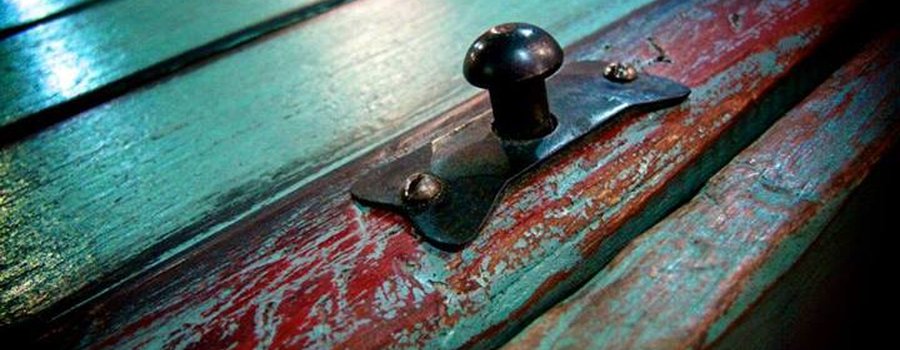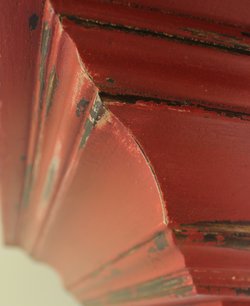After an article on Flour Paint, here's Milk Paint, an ecological, versatile, unique paint which provides a beautiful rustic look to any surface. We see you coming… don’t worry: the next article will not be about egg paint or pancake recipes… we’ll stick with wood finishing!
Enough about Flour… let’s talk about Casein!
Milk paint takes its name from its main ingredient, casein, a milk protein. Forgotten for many years, this paint resurfaced lately: its durability, ease of application, natural ingredients and unique finish are certainly no stranger to its success. It can be bought as colored powder ready to be mixed with water, but it can also be made at home from skimmed milk, cottage cheese or dry curd cheese and pigments.
Milk paint comes from an old North American recipe that dates back to the 17th century. Surprisingly, milk paint cannot be found in Europe. Milk paint has long contributed to the embellishment of furniture, woodwork and North American buildings in the 19th and 20th century, which took their color from locally available pigments. Thus, in Trois-Rivières, the people in the fields used to excavate red earth, which they then grinded with linseed oil and skim milk to make paint. In the Québec region, in Ancienne-Lorette and St-Augustin, a thin horizontal layer of yellow clay of a beautiful dark color could be found in the soil at a depth of about one meter, which when mixed with white paint, gave a great variety of ochre hues. Once cooked, it provided a beautiful red-orange color.

Today, color possibilities are endless thanks to the availability of pigments originating from everywhere on the planet, and Milk Paint is back, to the delight of wood finishing amateurs and professionals who wish to use environmentally friendly products that are part of a sustainable development perspective.
This paint will not flake off (unless of course you want to give it a chipped antique finish...), will not peel, will provide a country-style finish and patina. It allows a wide variety of effects and textures for both a contemporary finish on furniture or kitchen cabinets, or as a whitewash effect on the walls in order to create a European ambiance. The biggest advantage of milk paint certainly its ability to be antiquated. Indeed, milk paint allows the wood grain as well as its textures to be exploited. You will see that with a little patience and experimentation, it's possible to obtain finishes which will look like your furniture has a 100 years of natural wear.
A greater level of control over the finishing process
Milk paint is an economical and attractive means for those who wish to have more options and more control over their finishing project. First, Milk paint can be used either as paint or as a dye (wash), depending on the amount of water that will mixed with the powder. The wash allows wood details to show through, and can be protected with any finishing product such as wax, varnish or oil.
Milk paint is very interesting for those who want to give a worn antique finish (such as cracks) to their project: By varying the thickness of the paint, or by strategically using a crackling medium, it is possible to obtain a wide variety of results. Since it is sold in powder form, milk paint requires a little more work than regular paint, but in return offers opportunities which are as endless as your creativity.
A versatile paint with non-toxic ingredients
Milk paint contains harmless ingredients: It contains no solvents and no VOC (Volatile Organic Compounds).
In addition to casein and borax (which activates the milk protein), Milk paint contains mainly kaolin (a form of clay), and limestone in the form of lime and calcium carbonate (which is the main component of shells of crustaceans, snails, pearls, and eggshells). It also contains mineral pigments (various oxides).
Milk paint is typically used on unfinished wood or other porous surfaces such as plaster, concrete, clay or cardboard. However, adding 5% methylcellulose powder, will make the paint creamier, will avoid sedimentation (which eliminates the need to mix it too often) and will also improve its adherence, allowing it to be applied on any well prepared surface, while also making its application by roller much easier. Methylcellulose is made from wood cellulose (fiber), and has many uses, both in the food industry (as an additive) and film (special effects). Interestingly, it is also used in the porn industry ... but we'll let you Google if you're interested!
Using an acrylic-based ultra-adherent primer will further enhance adherence and will allow Milk paint to be easily applied on any surface such as glass, metal, varnish, oil painting, ceramic or plastic.
The more adventurous type might also be tempted to make their own paint at home. Several recipes using skim milk or cottage cheese are available all over the web, but results and efficiency vary. Here are two recipes whose results have been proven. The approximate cost for the skim milk based paint is around $4 for a pint, compared to fifteen dollars for powder mix. Note that in all cases, it is better to prepare only the amount of paint needed for your project, as casein, like milk, will not keep for a very long time. You can store the remaining paint in the refrigerator for a few days at most. Benefits of the powder mix is that it can be stored indefinitely as long as it’s not mixed with water, and it is available in a wide range of colors with both antique and contemporary tones.
Milk paint and antique, worn finish
Use of Milk paint as an alternative to regular paint is quite simple. To summarize, you need to clean the surface prior to painting, then sand, decide whether or not methyl or ultra-adherent primer will be added (depending on the surface to be painted), apply a first coat, sand lightly once dry, and finally apply the second coat, which will then be protected by applying a finish, whether varnish, wax or oil. This will also change the very matte finish.
However, as previously stated, Milk paint’s main interest is its ability to give a beautiful antique, worn finish. Here are two ways to get this type of finish:
- First Method (Simple, recommended for beginners)
- Second Method (For more experienced users, offers more options)
These techniques can be used on furniture, shelves, etc.
Next steps
You are now knowledgeable enough to undertake an antique finish project! Whether on new wood or to restore some old furniture lying around the house, Milk paint will give amazing results. Do you have a project in mind and asking yourself what would be the best way to achieve it? As usual, feel free to visit our technical forums to ask questions or share your project ideas!






